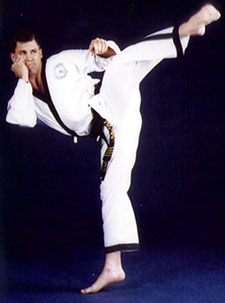Practicing Taekwondo
 Photo courtesy of Meyers & Maple Photography.
Sky Wood performs the scissor kick, which is a twist kick with the left foot
|
The room in which taekwondo is taught is called a dojang. A taekwondo student is called a Jeja; the teacher is called a Kyosa Nim. The Jeja should come to class with an open mind and a positive attitude. Training on a regular basis brings the student many benefits, including strength, flexibility, fitness, mental toughness, self-confidence, and new friends!
|
Fred Hackett demonstrates the turning kick pose. |
Skill levels in martial arts are denoted by the color of the student’s belt. To move from one taekwondo belt to the next level or grade, the student must take a test in which he or she will be evaluated on taekwondo patterns (forms), sparring, self-defense, breaking boards, fitness, etiquette, and spirit.
There are two common questions that students ask when they start practicing taekwondo: When will I move to the next level, and when will I become a black belt?
These questions are not easy to answer, since no two people are the same. One’s progress depends on many factors, including how many hours and effort one puts into training, the type of club one trains at, and how flexible one is. Every student is on his or her own journey. The different belt colors are one way to look at the journey.
This content has been re-published with permission from SEED. Copyright © 2025 Schlumberger Excellence in Education Development (SEED), Inc.


